初中英语教案模板(优秀8篇)
初中英语全英说课稿优秀8篇
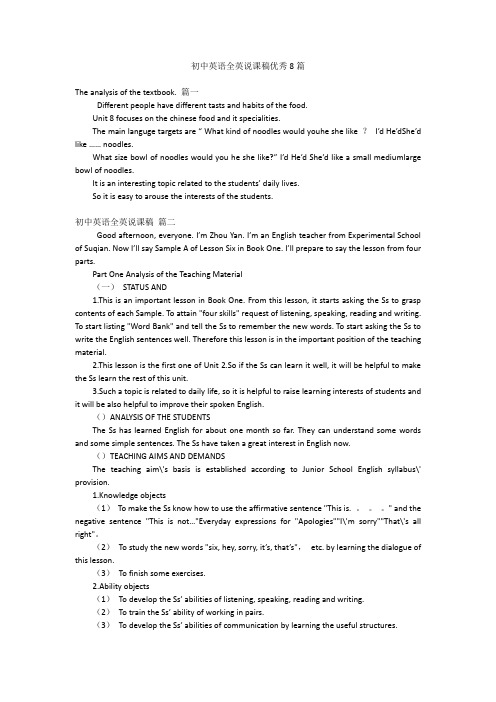
初中英语全英说课稿优秀8篇The analysis of the textbook. 篇一Different people have different tasts and habits of the food.Unit 8 focuses on the chinese food and it specialities.The main languge targets are “ What kind of noodles would youhe she like ?I’d He’dShe’d like …… noodles.What size bowl of noodles would you he she like?” I’d He’d She’d like a small mediumlarge bowl of noodles.It is an interesting topic related to the students’ daily lives.So it is easy to arouse the interests of the students.初中英语全英说课稿篇二Good afternoon, everyone. I’m Zhou Yan. I’m an English teacher from Experimental School of Suqian. Now I’ll say Sample A of Lesson Six in Book One. I’ll prepare to say the lesson from four parts.Part One Analysis of the Teaching Material(一)STATUS AND1.This is an important lesson in Book One. From this lesson, it starts asking the Ss to grasp contents of each Sample. To attain "four skills" request of listening, speaking, reading and writing. To start listing "Word Bank" and tell the Ss to remember the new words. To start asking the Ss to write the English sentences well. Therefore this lesson is in the important position of the teaching material.2.This lesson is the first one of Unit 2.So if the Ss can learn it well, it will be helpful to make the Ss learn the rest of this unit.3.Such a topic is related to daily life, so it is helpful to raise learning interests of students and it will be also helpful to improve their spoken English.()ANALYSIS OF THE STUDENTSThe Ss has learned English for about one month so far. They can understand some words and some simple sentences. The Ss have taken a great interest in English now.()TEACHING AIMS AND DEMANDSThe teaching aim\'s basis is established according to Junior School English syllabus\' provision.1.Knowledge objects(1)To make the Ss know how to use the affirmative sentence "This is. 。
初中英语课堂教学设计案例优秀9篇

初中英语课堂教学设计案例优秀9篇初中英语课堂教学设计案例篇一一、案例下面以“travels for the environment”为例,对阅读技能训练在教学中的应用加以说明,这篇文章内容含量大,涉及到热门话题——人口与环境,所以我把这篇文章放在初三英语11模块之后讲,在此之前学生在第六模块中谈论到了环保的话题。
我在处理这篇文章时,主要有以下几步:1.阅读前任务设计用多媒体播放,人多车多造成的交通道路拥挤,城市的大面积扩张造成了大面积耕地被占用,森林面积减少,然后提出如下问题:who courses such changes?what should we do?学生马上热烈地讨论起来,屏幕上的场景迅速激活了课堂,激发了学生的阅读兴趣,使他们产生了强烈的阅读愿望。
2.阅读中任务(while-reading task)(1)快速阅读,了解主旨大意(task 1)。
让学生在规定时间内默读完课文并找出每段的主题句或段落的中心句。
当然,学生也可以用不同的句子来概括每段的中心。
只要有自己的观点,都要给予肯定和表扬。
(2)精读,获取更多信息(task 2)。
为了帮助学生了解更多的信息,设计如下几个问题,让学生在文中找出相关信息,并小组讨论:1.From the paage we known that our earth has changed much because of _______. A.its old ageB.man’s activitiesC.the changes of weatherD.the natural development2.Water pollution will bee even worse if __________. A.birds and fish continue to dieB.people continue to built factoriesC.people can’t stop factories from sending waste things into waterD.many rivers and lakes are still dead(3)研读,从中受到启发(task 3)。
版初中英语教案全英文【8篇】

版初中英语教案全英文【优秀8篇】最新初中英语教案篇一一、教学目标在本节课结束时,学生将能够:用正确的语言谈论如何学习;用by+ doing的结构描述自己的学习方式;能够就英语学习与他人进行简单的口语交流。
知识与能力:通过本课学习,用目标语言谈论如何学习英语,就英语问题进行简单的沟通,同时在与他人的合作与交流中帮助他人,树立自己学习的信心。
过程与方法:采用小组合作探究、听力练习、对话练习、猜测问题和角色互换的学习策略,利用视频、PPT和制作课件等来展开课堂教学环节等,进行“询问和谈论学习方法、解决困惑” 的课堂教学和练习。
本单元的教学法建议:短语教学——采取情景引入展开启发式的教学方式,让学生在思考中输出自己的语言,并在句型中学会运用;语音教学——让学生进行听对话并跟读听力材料;口语教学——采取对话练习和角色互换对学生进行教学;听力教学——采取听音配对、听音打钩和听音对应等的方式进行听力教学和听力技巧指导;口语教学——通过创设情境让学生进行对话练习和角色互换活动,来进行语言的输出。
情感态度与价值观:通过参与课题教学活动,增进同学之间的了解和友情,并在交流中了解英语学习的方法,建立学习英语的自信。
二、教学重难点教学重点:学习并掌握How do you study...? I study...by ....等相关句型和词汇。
学习并掌握用by + doing 结构表达方式方法。
教学难点:学习并用丰富的语言描述英语学习的方式和方法。
三、教学策略短语教学——采取视频引入话题然后进行启发式教学,并在对话中运用;语音教学——让学生跟读听力材料进行模仿式操练;口语教学——采取pair work 和Role- play问答式的口语交际活动或小组活动互相操练;听力教学——采取采取听音配对、听音打钩和听音对应等方式语法教学——通过模仿听力材料进行对话练习,在教师的纠正中培养正确的by + doing 的结构意识。
初中英语公开课教案篇二课前准备教师:准备游戏时所用的图片(食物、蔬菜、动物)。
七年级上册英语教案人教版免费
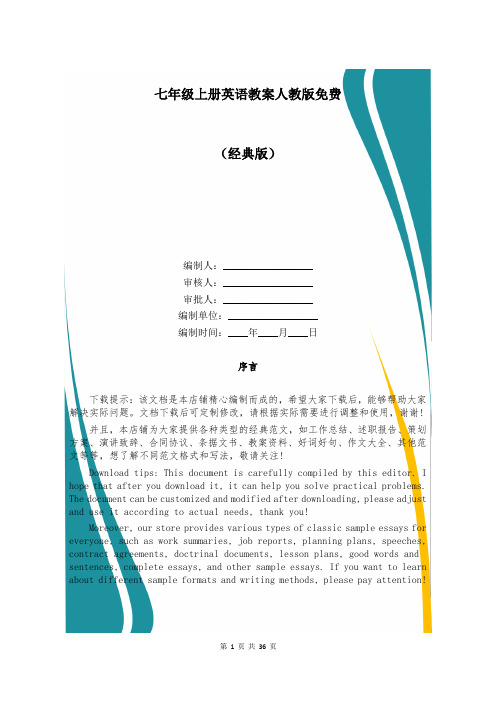
七年级上册英语教案人教版免费(经典版)编制人:__________________审核人:__________________审批人:__________________编制单位:__________________编制时间:____年____月____日序言下载提示:该文档是本店铺精心编制而成的,希望大家下载后,能够帮助大家解决实际问题。
文档下载后可定制修改,请根据实际需要进行调整和使用,谢谢!并且,本店铺为大家提供各种类型的经典范文,如工作总结、述职报告、策划方案、演讲致辞、合同协议、条据文书、教案资料、好词好句、作文大全、其他范文等等,想了解不同范文格式和写法,敬请关注!Download tips: This document is carefully compiled by this editor. I hope that after you download it, it can help you solve practical problems. The document can be customized and modified after downloading, please adjust and use it according to actual needs, thank you!Moreover, our store provides various types of classic sample essays for everyone, such as work summaries, job reports, planning plans, speeches, contract agreements, doctrinal documents, lesson plans, good words and sentences, complete essays, and other sample essays. If you want to learn about different sample formats and writing methods, please pay attention!七年级上册英语教案人教版免费最新七年级上册英语教案人教版免费(8篇)作为一位不辞辛劳的人·民教师,通常会被要求编写教案,那么关于七年级上册英语教案怎么写呢?以下是本店铺准备的一些七年级上册英语教案人教版免费,仅供参考。
初中英语教学案例模板(精选10篇)
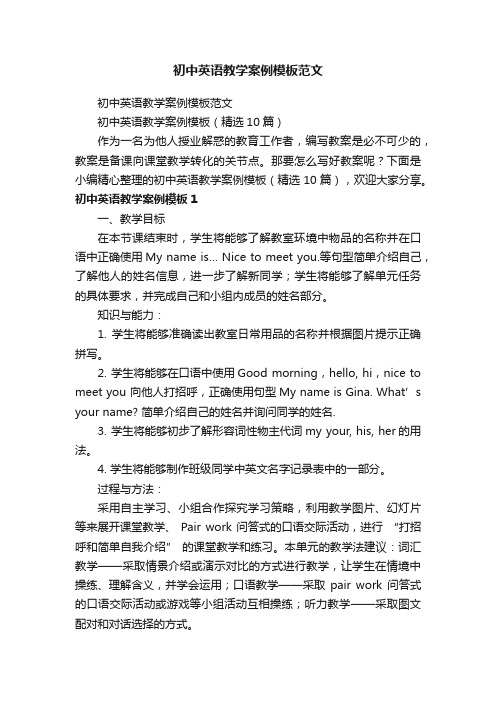
初中英语教学案例模板范文初中英语教学案例模板范文初中英语教学案例模板(精选10篇)作为一名为他人授业解惑的教育工作者,编写教案是必不可少的,教案是备课向课堂教学转化的关节点。
那要怎么写好教案呢?下面是小编精心整理的初中英语教学案例模板(精选10篇),欢迎大家分享。
初中英语教学案例模板1一、教学目标在本节课结束时,学生将能够了解教室环境中物品的名称并在口语中正确使用My name is… Nice to meet you.等句型简单介绍自己,了解他人的姓名信息,进一步了解新同学;学生将能够了解单元任务的具体要求,并完成自己和小组内成员的姓名部分。
知识与能力:1. 学生将能够准确读出教室日常用品的名称并根据图片提示正确拼写。
2. 学生将能够在口语中使用Good morning,hello, hi,nice to meet you 向他人打招呼,正确使用句型My name is Gina. What’s your name? 简单介绍自己的姓名并询问同学的姓名.3. 学生将能够初步了解形容词性物主代词my your, his, her的用法。
4. 学生将能够制作班级同学中英文名字记录表中的一部分。
过程与方法:采用自主学习、小组合作探究学习策略,利用教学图片、幻灯片等来展开课堂教学、 Pair work 问答式的口语交际活动,进行“打招呼和简单自我介绍” 的课堂教学和练习。
本单元的教学法建议:词汇教学——采取情景介绍或演示对比的方式进行教学,让学生在情境中操练、理解含义,并学会运用;口语教学——采取pair work 问答式的口语交际活动或游戏等小组活动互相操练;听力教学——采取图文配对和对话选择的方式。
情感态度与价值观:通过学生之间的互相认识,培养学生广交朋友及友好相处的品质。
二、教学重难点教学重点:1. 能够介绍自己的姓名:My name is …I’m…2. 能够简单问候初识的朋友:Hello!/Hi! Good morning! Nice to meet you!3. 能够正确使用形容词性物主代词my your, his, her三、教学策略词汇教学——采取情景介绍或演示对比的方式进行教学,让学生在情境中操练、理解含义,并学会运用;口语教学——采取pair work 问答式的口语交际活动或游戏等小组活动互相操练;听力教学——采取图文配对和role-play的方式;四、教学过程略初中英语教学案例模板21、写课题(Topic)和课型(LessonType)课题相当于文章的标题,讲课时要首先告诉学生,并写在黑板上。
初中英语教案范本8篇
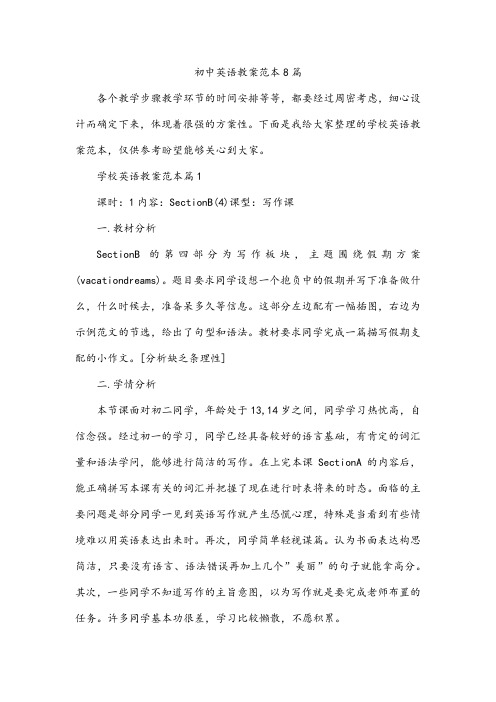
初中英语教案范本8篇各个教学步骤教学环节的时间安排等等,都要经过周密考虑,细心设计而确定下来,体现着很强的方案性。
下面是我给大家整理的学校英语教案范本,仅供参考盼望能够关心到大家。
学校英语教案范本篇1课时:1内容:SectionB(4)课型:写作课一.教材分析SectionB的第四部分为写作板块,主题围绕假期方案(vacationdreams)。
题目要求同学设想一个抱负中的假期并写下准备做什么,什么时候去,准备呆多久等信息。
这部分左边配有一幅插图,右边为示例范文的节选,给出了句型和语法。
教材要求同学完成一篇描写假期支配的小作文。
[分析缺乏条理性]二.学情分析本节课面对初二同学,年龄处于13,14岁之间,同学学习热忱高,自信念强。
经过初一的学习,同学已经具备较好的语言基础,有肯定的词汇量和语法学问,能够进行简洁的写作。
在上完本课SectionA的内容后,能正确拼写本课有关的词汇并把握了现在进行时表将来的时态。
面临的主要问题是部分同学一见到英语写作就产生恐慌心理,特殊是当看到有些情境难以用英语表达出来时。
再次,同学简单轻视谋篇。
认为书面表达构思简洁,只要没有语言、语法错误再加上几个”美丽”的句子就能拿高分。
其次,一些同学不知道写作的主旨意图,以为写作就是要完成老师布置的任务。
许多同学基本功很差,学习比较懒散,不愿积累。
三.教学目标分析1.语言学问目标2.语言技能目标能运用本课的词汇与句型写调查报告,介绍自己以及小组同学的度假支配;3.情感态度目标能在描述自己的方案和准备时,激起同学更加喜爱祖国的美妙河山。
4.学习策略目标:1.在学习中集中留意力;乐观思索;擅长记要点;2.学会科学支配自己的假期活动,能和合作伙伴相互沟通,充分交换信息。
3.能在小组活动中乐观与他人合作,相互关心,共同完成学习任务;4.在使用英语中,能意识到错误并进行适当的订正;5.文化意识目标了解英美国家的人们在工作之余是如何轻松度假的。
初中英语优秀教案模板范文(汇总12篇)

初中英语优秀教案模板范文(汇总12篇)(经典版)编制人:__________________审核人:__________________审批人:__________________编制单位:__________________编制时间:____年____月____日序言下载提示:该文档是本店铺精心编制而成的,希望大家下载后,能够帮助大家解决实际问题。
文档下载后可定制修改,请根据实际需要进行调整和使用,谢谢!并且,本店铺为大家提供各种类型的经典范文,如工作总结、工作计划、合同协议、条据文书、策划方案、句子大全、作文大全、诗词歌赋、教案资料、其他范文等等,想了解不同范文格式和写法,敬请关注!Download tips: This document is carefully compiled by this editor. I hope that after you download it, it can help you solve practical problems. The document can be customized and modified after downloading, please adjust and use it according to actual needs, thank you!Moreover, our store provides various types of classic sample essays for everyone, such as work summaries, work plans, contract agreements, doctrinal documents, planning plans, complete sentences, complete compositions, poems, songs, teaching materials, and other sample essays. If you want to learn about different sample formats and writing methods, please stay tuned!初中英语优秀教案模板范文(汇总12篇)初中英语优秀教案模板范文第1篇教学目标:1、能听懂、会说、会读、会拼写词汇look for, join, study.2、能听懂、会说、会读日常交际用语和句型Classes are over.Perhaps they are.I’ll go and join them.Where are you going? I’m going to …3、培养学生乐于助人的良好思想品质。
初中英语课教学设计(共8篇)(精简版)

初中英语课教学设计(共8篇)初中英语课教学设计(共8篇)篇一:初中英语课堂教学设计初中英语课堂教学设计课题:Unit 4 It as built over 2,000 years ago 设计人:黑龙江省泰来县孙放图片已关闭显示,点此查看图片已关闭显示,点此查看图片已关闭显示,点此查看图片已关闭显示,点此查看篇二:初中英语教案模板Teaching Plan Student: The students of Grade 9 Teaching Content: Go for it, students’ book of grade 9. Unit 1, the title is Ho do you study for a test? Section B, 3a, 3b,3c. Teaching hour: One class hour Teaching plan: I. Teaching Aims: 1. Learn and master ne ords, phrases and sentence patterns.2. Enable the students to talk in English about ho to study English very ell.3. Develop the students speaking and riting ability. II. Teaching Main Points: 1. Improve the students’ speaking and riting ability. 2. Master some phrases and some sentence patterns. III. Teaching Difficult Points: 1. Phrases: first of all, later on, laugh at, take notes 2. Sentence Patterns: Sb. be afraid to do sth. Sb. realize that –clause IV. Teaching Methods: 1. Fast reading to find out the general information about the passage.2. Question-and-anseractivities to help the students to go through the hole passage.3. Individual, pair and group ork to make every student ork in class. V. Teaching Aids: The blackboard VI. Teaching Procedures: 图片已关闭显示,点此查看图片已关闭显示,点此查看 The Blackboard Design: 图片已关闭显示,点此查看篇三:初中英语教案Lesson Plan Born Dying Objectives: a. Let the students kno something about AIDS. For example: What is AIDS? Ho does a person get AIDS? b. Let the students kno the psychological state and learn to care for those AIDS patients. c. Cultivate the students’ability to analyze the topic a nd try to get the supporting points. d. Teach students ho to use subjunctive.Important Points/Grammar: a. Cultivate the students’ability to analyze the topic and try to get the supporting points. b. Let the students kno those AIDS patients’ psychological state and learn to care for them. c. Teach subjunctive. d. ne ords and phrases:immune system;be inflected ith; survive; suffer from; cheer up; available; persuade. Teaching aids: Pictures, slides, pieces of paper ith different tasks on Procedure Warm-up/Lead-in Activities: Hold a general knoledge test in class by asking some questions related to AIDS, such as hat’s the date of orld AIDS DAY? What’s AIDS? Ho do people get AIDS? What’s the symbol of it? And so on,to stimulate students’ enthusiasm. Stage1, Reading: a. Involve students in reading the text to get familiar ith the content. b. After finishing reading, ask students five questions: 1. What’s AIDS? 2. Ho do people get AIDS? 3. What kind of life does Xiaohua live? 4. What do the AIDS patients suffer from? 5. If you have got ADIS, ho ould you live your rest life? c. Teach students the to important reading methods: skimming and scanning. Then, ask them to read the text once again by using skimming to find the main idea of the text and using scanning to find more specific information of this text.d. After reading, let them present their on ansers of these five questions. Stage 2, Text Explaining: Divide the hole class into 7 groups, every group focuses on one paragraph and finds out the important information hich supports the text. At first, ment the anser of every group. Then explain the text systematically. The text consists of some information as follos: Para1: Xiaohua is?; she is? Para2: AIDS is a disease \ breaks don \ leave \defenseless Para3: via unprotected sex; infected blood transfusion or through birth Para4: Children infect \ the young suffer Para5: not discouraged \ encourage visit \ support \ cheer up \Telling \ encouraging \ creating Para6: Disease\fear \ ignorance \ misunderstanding Para7: “M y life may have to be short, but there is no reason hy itcan’t be beautiful” Introduce to students hat subjunctive is. Then ask students to find out the sentences hich contain subjunctive. The sentences are: 1. I ish my mum ere here ith me and that e eren’t’t sick.2. If I ere to live long enough to have a job, I ould choose to be a doctor, helping these AIDS patients.3. I ish people ould find out the facts and not act as if I ere a bad or dangerous person.4. If I ere you, I ould give an AIDS patient a hug. Stage3, Oral English Practice: First, Let students talk about their dreams about future in small groups by using subjunctive. Then, every group assigns a representative to share his dreams ith the hole class. Stage4, Production: Guided, Meaningful Production Written ork: Ask students to pretend to be Xiaohua’s friends. According to the content of the text, everyone rites a short letter to Xiaohua for greeting. Students are directed to use at least some examples of the structures ithin the text. Then, pick out the best one and read it in front of the students. Homeork: Assign students supplementary reading to practice subjunctive in real context. Assessment.初中英语教学设计 Teaching Aims and Demands: nguage knoledge: Key vocabulary: dining, hall, gym, science, lab, in front of, next, behind, any, one, building Key structure: there be … 2. Reading skill: Teaching Procedures: 教师事先藏好自己的几样东西,上课时假装找不到(注意这时教师要使用丰富的体态语言和脸部表情,让学生感觉到这是真实的),这样就自然地呈现了新的句型:Where is….? It’s on / on / in / in front of / behind / next to… Where are …? They’re on / in / in front of / behind / next to… 设计意图:通过设置让学生帮老师找东西这样一个真实的场景来导入新课,能够立刻调动起学生的参与性,启动学习的发生。
初中英语教案(初中英语教案(建议8篇)
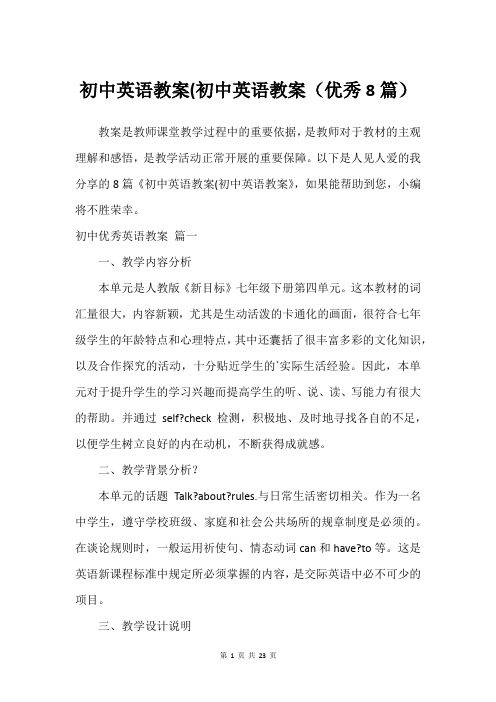
初中英语教案(初中英语教案(优秀8篇)教案是教师课堂教学过程中的重要依据,是教师对于教材的主观理解和感悟,是教学活动正常开展的重要保障。
以下是人见人爱的我分享的8篇《初中英语教案(初中英语教案》,如果能帮助到您,小编将不胜荣幸。
初中优秀英语教案篇一一、教学内容分析本单元是人教版《新目标》七年级下册第四单元。
这本教材的词汇量很大,内容新颖,尤其是生动活泼的卡通化的画面,很符合七年级学生的年龄特点和心理特点,其中还囊括了很丰富多彩的文化知识,以及合作探究的活动,十分贴近学生的`实际生活经验。
因此,本单元对于提升学生的学习兴趣而提高学生的听、说、读、写能力有很大的帮助。
并通过self?check检测,积极地、及时地寻找各自的不足,以便学生树立良好的内在动机,不断获得成就感。
二、教学背景分析?本单元的话题Talk?about?rules.与日常生活密切相关。
作为一名中学生,遵守学校班级、家庭和社会公共场所的规章制度是必须的。
在谈论规则时,一般运用祈使句、情态动词can和have?to等。
这是英语新课程标准中规定所必须掌握的内容,是交际英语中必不可少的项目。
三、教学设计说明本课通过不同种类的规则,谈论学生应该遵循那些规则,主要是应用祈使句、情态动词can和have?to等,可以说,本节新课是对这一语法的具体操练。
本课使用多媒体课件教学,用不同类型的规则和地点图片来吸引学生,激发学生学习的积极性。
四、教学过程Step 1 Warming?up and revision1、教师进入教室后,使用祈使句要求学生们完成一系列动作:Please stand up/sit down.Close the door, please.Look at me and listen to me.Dont open your books.Dont talk.Lets begin our class.(The teacher can also write down these sentences on the blackboard, and then let students find the characters of Imperative Sentences by themselves.)2.Show some pictures and lead in to the new words with the pictures:hallway classroom dinning hall fight arrive listen to…Step 2 Presentation1.Show the picture in 1a, and ask the students:(Point to the running boy)T: Whats the boy doing?S: Hes running.T: Where is he running?S: Hes running in the hallways.T: Can you run in the hallways?S: No, we cant.T: So please dont run in the hallways.(=You cant run in the hallways.)(板书、教读)学生跟读数遍,明白祈使句和“can”表达的含义。
初中英语说课稿优秀8篇
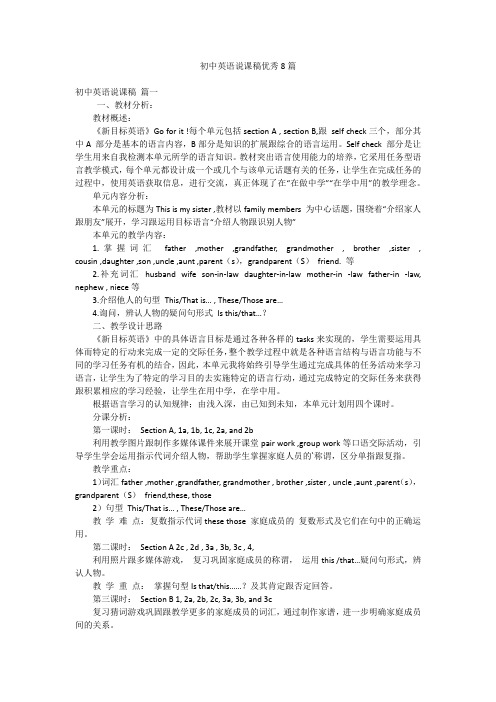
初中英语说课稿优秀8篇初中英语说课稿篇一一、教材分析:教材概述:《新目标英语》Go for it !每个单元包括section A , section B,跟self check三个,部分其中A 部分是基本的语言内容,B部分是知识的扩展跟综合的语言运用。
Self check 部分是让学生用来自我检测本单元所学的语言知识。
教材突出语言使用能力的培养,它采用任务型语言教学模式,每个单元都设计成一个或几个与该单元话题有关的任务,让学生在完成任务的过程中,使用英语获取信息,进行交流,真正体现了在“在做中学”“在学中用”的教学理念。
单元内容分析:本单元的标题为This is my sister ,教材以family members 为中心话题,围绕着“介绍家人跟朋友”展开,学习跟运用目标语言“介绍人物跟识别人物”本单元的教学内容:1.掌握词汇father ,mother ,grandfather, grandmother , brother ,sister , cousin ,daughter ,son ,uncle ,aunt ,parent(s),grandparent(S)friend. 等2.补充词汇husband wife son-in-law daughter-in-law mother-in -law father-in -law, nephew , niece等3.介绍他人的句型This/That is… , These/Those are…4.询问,辨认人物的疑问句形式Is this/that…?二、教学设计思路《新目标英语》中的具体语言目标是通过各种各样的tasks来实现的,学生需要运用具体而特定的行动来完成一定的交际任务,整个教学过程中就是各种语言结构与语言功能与不同的学习任务有机的结合,因此,本单元我将始终引导学生通过完成具体的任务活动来学习语言,让学生为了特定的学习目的去实施特定的语言行动,通过完成特定的交际任务来获得跟积累相应的学习经验,让学生在用中学,在学中用。
2024年初中英语教学案例(优秀8篇)

2024年初中英语教学案例(优秀8篇)初中英语教学案例篇一一、关注学生情感,创造民主、和谐的教学气氛。
学生只有对自己、对英语及其文化有积极的情态,才能保持英语学习的动力并取得成绩,刻板的情态,不仅会影响英语学习的效果,还会影响其它发展,情态是学好英语的重要因素,因此我努力创造宽松民主、和谐的教学空间,做到:1、尊重每个学生,积极鼓励他们在学习中的尝试,保护他们的自尊心和积极性。
2、把英语教学与情态有机地结合起来,创造各种合作学习的活动,促进学生互相学习,互相帮助,体验成就感,发展合作精神。
3、关注学习有困难的或性格内向的学习,尽可能地为他们创造语言的机会。
4、建立融洽、民主的师生交流渠道,经常和学生一起反思学习过程和学习效果,互相鼓励和帮助,做到教学相关。
二、面向全体学生,为学生全面发展和终身发展奠定基础。
1、创设各种情景,鼓励学生大胆地使用英语,对他们在学习过程中的失误和错误采取宽容的态度。
2、为学生提供自主学习和直接交流的机会,以及充分表现和自我发展的一个空间。
3、鼓励学生通过体验、实践、合作、探索等方式,发展听、说、读、写的综合能力。
4、创造条件让学生能够探究他们自己的一些问题,并自主解决问题。
三、加强对学生学习策略的指导,让他们在学习和适用的过程中逐步学会如何学习做到:1、积极创造条件,让学生参与到阶段性学习目标,以及实现目标的方法。
2、引导学生结合语境,采用推测、查阅和协调的方法进行学习。
3、引导学生在学习过程中,进行自我评价,并根据需要调整自己的学习目标和学习策略。
四、对学生进行有效的评价。
评价可以使学生认识自我,树立自信,有助于反思及调整自己的学习过程,评价或采用测验及非测验形式,平时重视形成性评价,对学生回答学习过程中的表现所改进的诚绩,及反映的情感、态度、策略某方面进行及时的评价,如有口头评价、等级评价、学生之间互相评价等方法,充分发觉学生的进步,鼓励学生自我反思,自我提高,测验以学生综合运用能力为目标,侧重于学生理解和获取信息,能力减少客观题,增加主观题,通过评价学生学会分析自己的成绩和不足,明确努力方向。
初中英语全英说课稿优秀8篇
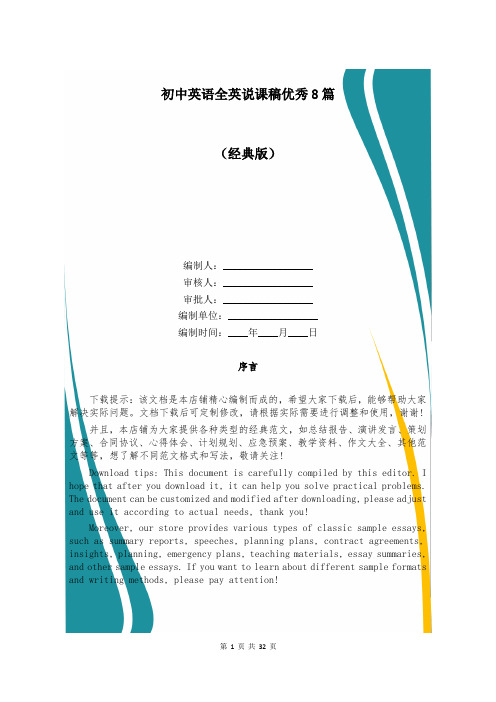
初中英语全英说课稿优秀8篇(经典版)编制人:__________________审核人:__________________审批人:__________________编制单位:__________________编制时间:____年____月____日序言下载提示:该文档是本店铺精心编制而成的,希望大家下载后,能够帮助大家解决实际问题。
文档下载后可定制修改,请根据实际需要进行调整和使用,谢谢!并且,本店铺为大家提供各种类型的经典范文,如总结报告、演讲发言、策划方案、合同协议、心得体会、计划规划、应急预案、教学资料、作文大全、其他范文等等,想了解不同范文格式和写法,敬请关注!Download tips: This document is carefully compiled by this editor. I hope that after you download it, it can help you solve practical problems. The document can be customized and modified after downloading, please adjust and use it according to actual needs, thank you!Moreover, our store provides various types of classic sample essays, such as summary reports, speeches, planning plans, contract agreements, insights, planning, emergency plans, teaching materials, essay summaries, and other sample essays. If you want to learn about different sample formats and writing methods, please pay attention!初中英语全英说课稿优秀8篇说课活动分课前说课和课后说课两种形式,不论是课前说课还是课后说课上述内容必须阐述清楚。
初中英语阅读课教案设计模板(共8篇)

初中英语阅读课教案设计模板(共8篇)第1篇:初中英语阅读课教案LESSON PLANTime of Leon: 45 minutes Students: Senior Grade OneTeaching Material: How Did Postage Stamps come Into Use Teaching Objectives:1.To train Ss' reading ability(such as gueing the meaning of new words in the context, the speed of reading.)2.T o train Ss' reading comprehension(To get meages from what they read.)Teaching Points:1.Ss get used to three reading skills.2.Ss understand the given paage.Properties:Stamps, letters, postcards, work sheets, OHP Teaching Method: communicative Approach Leon Type: Reading New Words and A Phrase:postage, put forward, proposal, seal, deliver, system, postal Procedures: Step 1.Warm-up(6')1.Lead-inShow some stamps, letters and postcards and have free talk to arouse students' motivation.2.Dealing with some new words Q: Do you know the postage of a letter?Explain "postage", and write postage on the Bb.postage: payment for the carrying of lettersA: Fifty fen for any place in China except Hong Kong, Taiwan and Macao.Q: What do the postmen do with the letters?A: They take the letters from the postbox and carry them away to the places on the envelopes and deliver them to the addreed people.Explain "deliver", and write deliver on the Bb.deliver: take letters or goods to the addreed people.Q: Who put forward the proposal to use stamps? Use OHP to project thequestion onto the screen.Explain "put forward" and "proposal", and write them on the Bb.put forward: put an idea before people for thinking over proposal: sth.proposed, plan or idea, suggestion Again: Who put forward the proposal to use stamps? Step 2.Skimming(4'30")1.InstructionsT: Now I give you a paage to read, and for the first time you should only find the answer to the question.You have only two and a half minutes to read.So don't read word for word.Read quickly.Just try to find the answer.2.Handing out the reading material and reading 3.CheckingQ: Who put forward the proposal to use stamps.A: Rowland Hill, a schoolmaster in England.Step 3.Scanning(6')1.Instructions T: This time I give you three minutes to read the paage.When you are reading, find the answers to the two e OHP to project the questions:1.Why was the postage high in the early nineteenth century when people did not use stamps?2.When was postage stamps first put to use? 2.Reading3.Checking 1)Pair work 2)Cla checkingAns.to Que.1.Because the post offices had to send many people to collect the postage.Ans.to Que.2.On May 6, 1840.Step 4.Full reading(21')1.InstructionsT: Now I give you ten minutes to read the paage for the third time and you should read it carefully.Before reading, let's go over the questions on the work sheet.Give Work Sheet 1 to the Ss.Explain the new words in Que.4.prevent: stop, not let sb.do sth.reuse: use againT: Try to find the answers to the questions.But don't write the answers down, you can put a sign or underline the sentences concerning the questions.2.Reading 3.Checking1)Group work: Checking the answers in a group of four Ss.2)Cla work: Checking the answers in cla.Poible Answers:1.Why were people unhappy to pay postage for letters in the early nineteenth century? Because they had to pay postage when they received letters, especially when they paid for a letter which they did not wish to receive at all.The postage was high.2.Why was it much easier for people to use stamps for postage? Because people could go to the nearby post office to buy stamps and put them on envelopes before they sent the letters.3.Why was the postage much lower using stamps?Because in this way, the post office did not need to send postmen to collect postage.It only needed to send fewer postmen to deliver letters.4.How could the post office prevent people from reusing the stamps?The post office could simply put seals on the stamps so that people could not use the stamps again.Check the understanding of the word "seal", and write it on the Bb.seal: ÓÊ´Á 5.Did other countries take up the new postal system? Yes.Check the understanding of "postal" and "system", and write them on the Bb.postal: of the post system: a set of working ways6.Does every country in the world has its own stamps? Yes.Step 5: Rounding-off(7')1.Answering Ss' questions on the paage if any.2.Making a guided-dialogue with the information given from the paage.Hand out Work Sheet 2.Do it in pairs.3.Asking two or three pairs to read their dailogues.A poible completed dialogue: A: Oh, What a beautiful stamp!B: Yes, it's from the U.S.A..A: Do you know in the early nineteenth century people did not use stamps? B: Then how did they pay the postage?A: They had to pay the postage when they received letters.B:Was the postage very high then?A: Yes.Because the post offices had to send many people to collect the postage.B: Who put forward the proposal to use stamps? A: Rowland Hill, a schoolmaster in England.B: Why do post offices put seals on the stamps? A: They can prevent people from using the stamps again.B: When did post offices begin to sell stamps? A: On May 6, 1840.B: Thank you for telling me so many things about stamps.Step 6.Aignment(30")Ask the Ss to shorten the paage within four or five sentences after cla, and to write it in their exercise books.************************************************************ *Reading Material:How Did Postage Stamps come Into UseWhen you send a letter or a postcard, you have to put stamps on the envelope or on the card.When did people first begin to use stamps? Who was the first to think of this idea? In the early nineteenth century, people did not use stamps.They had to pay postage when they received letters.They were unhappy about this, especially when they paid for a letter which they did not wish to receive at all.The postage was high at that time, because the post offices had to send many people to collect the postage.Rowland Hill, a schoolmaster in England, was the first to put forward a proposal to use stamps.He thought it would be much easier for people to use stamps to cover postage.They could go to the nearby post office to buy stamps and put them on envelopes before they sent the letters.The post office could simply put seals on the stamps so that people could not use the stamps again.In this way, the post office did not need to send postmen to collect postage.It only needed to send fewerpostmen to deliver letters.That was a good idea and the government finally accepted it.On May 6, 1840, post offices throughout England began to sell stamps.Soon this new postal system was taken up by other countries.Now each country has its own stamps.And there are many people who collect stamps all over the world.Work Sheet 1:Find the answers to the following questions from the paage: 1.Why were people unhappy to pay postage for letters in the early nineteenth century?2.Why was it much easier for people to use stamps for postage?3.Why was the postage much lower using stamps?4.How could the post office prevent people from reusing the stamps?5.Did other countries take up the new postal system?6.Does every country in the world has its own stamps now? Work Sheet 2:complete the dialogue with the information you have got: A: Oh, What a beautiful stamp!B: Yes, it's from the U.S.A..A: Do you know ____________________ people did not use stamps?B: Then how did they pay the postage? A: ___________________________________________________________.B: Was the postage very high then? A: ___________________________________________________________.B: Who put forward the proposal to use stamps? A: ___________________________________________________________.B: Why do post offices put seals on the stamps? A: ___________________________________________________________.B: When did post offices begin to sell stamps? A: ___________________________________________________________.B: Thank you for telling me so many things about stamps.第2篇:初中英语阅读课教学设计一、背景现行初中英语教材具有很多的优点,但由于学生认知水平的发展具有规律性,教师只有充分认识和掌握这种规律,并结合教学实际,合理设计教学程序,充分发挥学生的主体作用,教学相长,才能达到教学效果的最优化。
初中英语备课教案模板【优秀7篇】
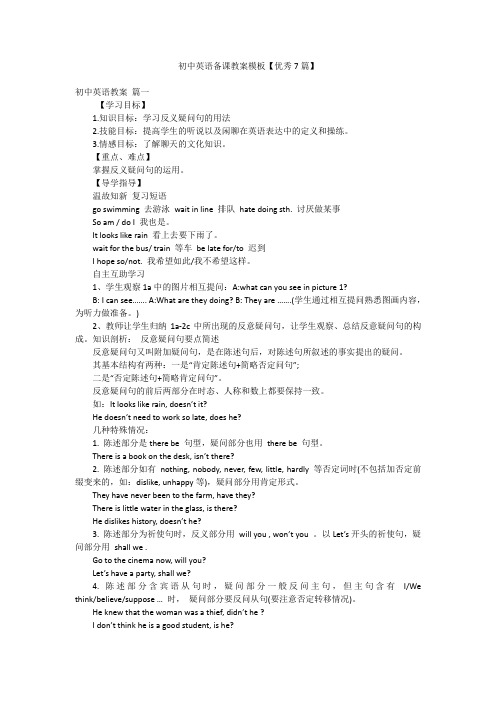
初中英语备课教案模板【优秀7篇】初中英语教案篇一【学习目标】1.知识目标:学习反义疑问句的用法2.技能目标:提高学生的听说以及闲聊在英语表达中的定义和操练。
3.情感目标:了解聊天的文化知识。
【重点、难点】掌握反义疑问句的运用。
【导学指导】温故知新复习短语go swimming 去游泳wait in line 排队hate doing sth. 讨厌做某事So am / do I 我也是。
It looks like rain 看上去要下雨了。
wait for the bus/ train 等车be late for/to 迟到I hope so/not. 我希望如此/我不希望这样。
自主互助学习1、学生观察1a中的图片相互提问:A:what can you see in picture 1?B: I can see……. A:What are they doing? B: They are …….(学生通过相互提问熟悉图画内容,为听力做准备。
)2、教师让学生归纳1a-2c中所出现的反意疑问句,让学生观察、总结反意疑问句的构成。
知识剖析:反意疑问句要点简述反意疑问句又叫附加疑问句,是在陈述句后,对陈述句所叙述的事实提出的疑问。
其基本结构有两种:一是“肯定陈述句+简略否定问句”;二是“否定陈述句+简略肯定问句”。
反意疑问句的前后两部分在时态、人称和数上都要保持一致。
如:It looks like rain, doesn’t it?He doesn’t need to work so late, does he?几种特殊情况:1. 陈述部分是there be 句型,疑问部分也用there be 句型。
There is a book on the desk, isn’t there?2. 陈述部分如有nothing, nobody, never, few, little, hardly 等否定词时(不包括加否定前缀变来的,如:dislike, unhappy等),疑问部分用肯定形式。
初中英语教案设计优秀9篇

初中英语教案设计优秀9篇优秀初中英语教学设计篇一一、指导思想我们全体七年级英语教师,在上一学期经过共同努力取得较好成绩的基础上,继续坚持面向全体学生,趁势而上,进一步深入搞好教学工作。
二、工作目标积极全面开展教学、教育和科研工作,通过整个备课组的努力,力争英语成绩在去年的水平上有一定程度的提高。
三、具体措施1、加强理论学习,更新教学观念,统一教育思想。
全组教师重点学习《基础教育课程改革纲要》、《英语课程标准》等有关课程改革的材料。
认真体会和理解新课程标准中的理念,并用这些理念来指导平时的课堂教学,以提高课堂教学效率。
2、加强备课组建设,抓好业务学习。
首先把备课组工作具体化,目标化,制度化。
加强备课组自身建设:①准时参加每周三的备课组活动,不迟到,不早退,不无故请假。
②中心发言人,提前做好充分准备,积极发言,写好有关备课材料。
③各组员积极发言,各抒己见,百花齐放,做到一人有高招,大家都受益,提倡团队合作,严禁单打独斗。
④组织业务学习,组内互学互提高。
⑤准时上缴教案、听课笔记等。
3、狠抓教学常规,规范教学工作发挥集体备课的群体优势,通过提高备课质量,落实教学常规,提高课堂教学效率。
强调每一位教师要在备课中,严格按照学校的要求,做到清晰、规范,备过程、备方法、备教材、备学生,。
充分利用本校的电脑和网络的优势,运用现代教学理论设计多媒体教学辅助课件,推动学科教学与信息技术的有效整合。
课后认真反思,及时总结得失,以利于以后的教学。
要求教师布置适量练习,教师细心批改,了解学生掌握知识情况,组内及时交流各班存在的共性问题,便于及时弥补。
诚心听课,真心评课,认真写好听课笔记,便于评课时集体评议,多指缺点,少唱赞歌,做到共同学习,共同提高。
四、具体工作9月份1.讨论好教学进度,提前备好一到两周的课。
2.做好假期作业的检查工作。
3.集体备课。
10月份1组织同组教师认真参加浦东新区教学展示周的听课、评课活动。
2开展好组内教研活动。
初中英语教师教学教案及设计7篇

初中英语教师教学教案及设计7篇初中英语教师教学教案及设计精选篇1一、教学目标:1.语言知识和能力目标:1)能掌握以下单词:anyone,any过去时间之前的行为。
2、灵活运用已经学过的常用功能项目,进一步学习并掌握如何描写与分类,描写物体,和叙述等语言功能项目;3、恰当理解和表达义务、道歉和应答,忠告等交际功能;教学重点、难点教学重点教学重点是每单元的A部分。
A部分是基本的语言内容,该部分是以一幅新语言功能在实际生活中应用的图画展开的,所有重点词汇都在图画中描绘出来。
教学难点教学难点是每单元的B部分。
B部分是每个单元知识的扩展和综合的语言应用。
该部分是在循环A部分所呈现的语言的同时引出新的词汇。
教学措施一、听、说、读、写、四种技能相结合的教学模式。
听力教学与阅读教学是与写作教学结合在一起的,为了使学生更好地掌握,采用四种技能相结合的教学方法。
书中所有对话都配有录音,每部分第一个活动都需要学生边听边看图。
然后让学生确认录音中提及的物体,说话人或被谈话人,或者填出确实单词。
二、开展结对活动和小组活动可以为学生分配搭档,也可以让他们自己选择,在开展结队活动之前,要确保每个人都要理解词汇的意义并指导活动如何进行。
三、运用先学后教,当堂训练的教学模式,精讲基础知识,加强基本训练,培养运用语言交际的能力。
在训练中,要尽量使语言形式与语言本身相联系,不要做过多地语法及语言形式的练习。
四、教学具体措施1、摸清学生基本情况,逐步激励学生对英语产生学习兴趣。
2、重视课堂教学质量,逐步提高学生英语交际能力。
3、有意识培养学生听力、表述、朗读、书写和作业的基本能力。
4、重视思维过程系统编排,由浅入深,由易到难,由已知到未知,循序渐进,点面结合,逐步扩展,循环往现,以加深影响。
初中英语教师教学教案及设计精选篇2一、教学目标在本节课结束时,学生将能够学会表述家庭成员的称谓,学会用特殊疑问句来询问家人的称谓和介绍家人。
知识与能力能听懂有关介绍家庭成员的对话,并能根据提供的信息介绍家人。
初中英语教学设计【优秀14篇】
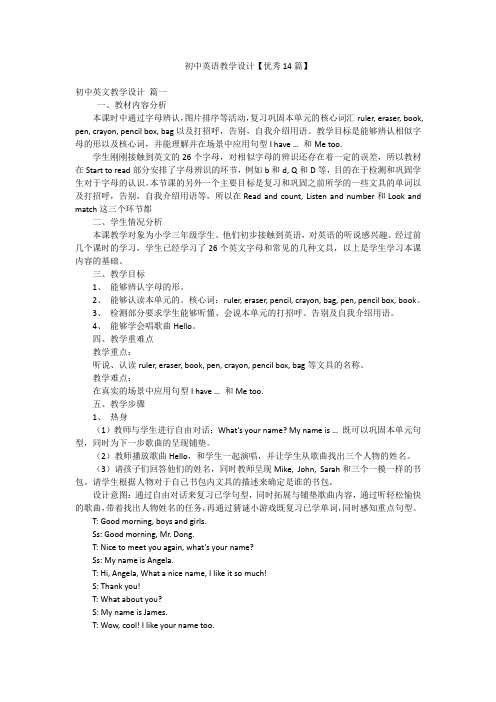
初中英语教学设计【优秀14篇】初中英文教学设计篇一一、教材内容分析本课时中通过字母辨认,图片排序等活动,复习巩固本单元的核心词汇ruler, eraser, book, pen, crayon, pencil box, bag以及打招呼,告别,自我介绍用语。
教学目标是能够辨认相似字母的形以及核心词,并能理解并在场景中应用句型I have … 和Me too.学生刚刚接触到英文的26个字母,对相似字母的辨识还存在着一定的误差,所以教材在Start to read部分安排了字母辨识的环节,例如b和d, Q和D等,目的在于检测和巩固学生对于字母的认识。
本节课的另外一个主要目标是复习和巩固之前所学的一些文具的单词以及打招呼,告别,自我介绍用语等,所以在Read and count, Listen and number和Look and match这三个环节都二、学生情况分析本课教学对象为小学三年级学生。
他们初步接触到英语,对英语的听说感兴趣。
经过前几个课时的学习,学生已经学习了26个英文字母和常见的几种文具,以上是学生学习本课内容的基础。
三、教学目标1、能够辨认字母的形。
2、能够认读本单元的。
核心词:ruler, eraser, pencil, crayon, bag, pen, pencil box, book。
3、检测部分要求学生能够听懂、会说本单元的打招呼、告别及自我介绍用语。
4、能够学会唱歌曲Hello。
四、教学重难点教学重点:听说、认读ruler, eraser, book, pen, crayon, pencil box, bag等文具的名称。
教学难点:在真实的场景中应用句型I have … 和Me too.五、教学步骤1、热身(1)教师与学生进行自由对话:What’s your name? My name is … 既可以巩固本单元句型,同时为下一步歌曲的呈现铺垫。
(2)教师播放歌曲Hello,和学生一起演唱,并让学生从歌曲找出三个人物的姓名。
初中英语教案模板优秀10篇

初中英语教案模板优秀10篇教案是教师课堂教学过程中的重要依据,是教师对于教材的主观理解和感悟,是教学活动正常开展的重要保障。
读书破万卷下笔如有神,下面小编为您精心整理了10篇《初中英语教案模板》,希望能够给您提供一些帮助。
中学英语教案篇八一、教学目标能正确把握表示颜色的单词。
二、教学重点、难点能正确把握表示颜色的单词。
三、教学预备颜色纸或各种实物、单词卡片四、教学过程step 1 revision1、教师出第一课时的三个句型认读。
2.t: what’s this?s: it’s a book.t: what are these?ss: books.t: how many books?s: ??t: is it blue?s: yes.t: is it red?s: no.继续换几种物品提问。
3、出示第二课时的句型订读。
最后的总结。
中学英语教案篇九教学目标:1、会使用可数名词和不可数名词开购物单。
为后两课学习购物做准备。
2、学会讨论吃什么饭,买什么东西。
3、复习一些礼貌用语和习惯表达,如:How about…?What about…?Can you come with me? What do you have for dinner this evening? Let me and have a look.等。
教学用具:录音机,实物投影仪,图片或实物等。
如有条件可做一商店的模型。
是的可更加生动真实。
教学步骤:Step 1 Revision[课件展示]值日生Duty Report。
教师让学生看图片编对话,两人一组操练对话。
同时教师总结售货员用语和顾客用语。
A: May I help you ?B: Thank you. I want …of …,please.A: Certainly. Here you are. Is that all?B: No. And some… please.A: How many do you want?B: About…,please.Step 2 Read and act[课件展示]教师可以点击图片播放影片让学生观看。
- 1、下载文档前请自行甄别文档内容的完整性,平台不提供额外的编辑、内容补充、找答案等附加服务。
- 2、"仅部分预览"的文档,不可在线预览部分如存在完整性等问题,可反馈申请退款(可完整预览的文档不适用该条件!)。
- 3、如文档侵犯您的权益,请联系客服反馈,我们会尽快为您处理(人工客服工作时间:9:00-18:30)。
初中英语教案模板(优秀8篇)如何才能写出一篇合格高效的教师教案?教师教案的写作其实不太难。
下面是的为您带来的8篇《初中英语教案模板》,希望能对您的写作有一定的参考作用。
初中英语教案篇一一。
词组互译:1. 允许进入,允许参加_ _2. 挣钱,赚钱___3. 一直,总是_ __4. 全世界_ __5. 谋生_ __6. 上大学___ _7. take away _ 8. get injured_9. have a good time__ 10. ask sb. to leave__二。
根据句意,用所给词的适当形式填空。
1. (watch)TV too much is bad for your eyes.2. Could you tell us the (different)between these two styles of music?3. They are much (friend)than I thought.4. The teacher (take)away my mobile phone because I used it in class.5. It rained very hard. And it made a few drivers (injure)in the race.三。
单项选择。
( )1. We’ll go to the Summer Palace _____ it doesn’t rain this Saturday.A. whenB. ifC. untilD. because( )2. Don’t ________ jeans to the party.A. put onB. wearC. wearingD. dress( )3. I’m going to ______ time with my grandparents this vacation.A. takeB. haveC. spendD. go( )4. This book isn’t useful. Please _______.A. take part inB. take it awayC. take away itD. take it out( )5. Jim asked me _______ him with his math.A. helpB. helpingC. helpedD. to help( )6. What ____ you ______ at eight yesterday evening?A. have, doneB. did, doC. were, doingD. will, do( )7. They found ______ they are famous for only a short time.A. itB. thisC. thatD. them( )8. Could you please _________ me the way to the hospital.A. showingB. showedC. showD. shown( )9. -I like flying all over the world. -I think being a ________ is just for you.A. teacherB. tour guideC. policemanD. doctor( )10. -What are you going to do tomorrow? -______.A. Nothing muchB. Much nothingC. Not anythingD. No thing中学英语教案篇二教学目标:1、学会问价钱。
2、学会最基本的卖东西用语,并会买东西。
3、继续学习可数名词与不可数名词的用法。
教学用具:录音机,实物投影仪,图片或实物等。
教学步骤:Step 1 Revision值日生Duty Report让值日生Duty Report加上买东西的内容。
如句型:I want to buy a bag of milk, some bread and two eggs for my tomorrow’s breakfast on my way home. My mother want to buy four potatoes, two kilos of fish, tow kilos of apples, 1 kilo of chicken legs.让值日生随意拿起某同学的物品,问:How much is your pen, please? 答:Maybe it’s … 问:How much are two pencils, please? 答:They’re …Step 2 Presentation引出今日新课:How much is …,please? How much are …,please? 教问价钱:how much … 教句型:How much is the…,please? How much are the …。
,please?老师可问一些同学们知道价钱的物品。
如:方便面,袋牛奶,可乐等。
练习回答:It’s …yuan a bag / a bottle / kilo. They are …yuan a kilo.将书上的114课第一部分的图用投影仪打出,就图提问。
练习课文的第一部分和第二部分。
可采取全班回答,小组回答,同桌回答等形式。
练熟为止。
Step 3 practice练习1:随意取些同学们书桌上的物品放在讲台上,提问同学。
可参考以下对话:A: This is a shop near our school. What things does the shop sell?B: Let me see. It sells pens, pencils, pencil-boxes, pencil-sharpeners…A: Does it sell bread / cakes / bottles milk…in the shop?B: Yes, it does. / No, it doesn’t.A: How much is it / are they? Do you know?教单词:tomato, onion, carrot练习2:在投影片上画一商店,列出一张价目表。
可参考以下对话:A: Which shop sells bread / milk / cakes / tomatoes / onion / carrot?B: The shop next to our school.A: Would you like to go with me?B: Certainly.教单词:cheap, expensive,cheap: not expensive expensive: not cheap练习3:In the shopA: Do you have tomatoes here?B: Yes, we do.A: How much are they?B: They are ten yuan a kilo.A: They are too expensive. What about that shop? Let’s have a look.A: OK.In the another shopA: I want to buy some tomatoes. How much are they?B: They are five yuan a kilo. How many do you want?A: They are cheap. I want three.B: Here you are.A: Here is the money. Bye!B: Bye!Step 4 Read and practice利用以上的所有道具练习第三部分对话。
注意:分别用上:How much is it? How much are they? Step 5 Consolidation学生们可自由编对话。
但老师要控制。
可给帮助学生们设计几个情景。
(参看教参P124)Step 6WorkbookHomeworkBlackboard HandwritingUnit 29 Shopping参考词New Words: how much, cheap, expensive tomatoUseful expressions onionHow much is it? It is …yuan a bag / bottle / kilo?carrotHow much are they? They are …a kilo.How many / How much do you want?初中优秀英语教案篇三一、教学目标在本节课结束时,学生将能够:用正确的语言谈论如何学习;用by+ doing的结构描述自己的学习方式;能够就英语学习与他人进行简单的口语交流。
知识与能力:通过本课学习,用目标语言谈论如何学习英语,就英语问题进行简单的沟通,同时在与他人的合作与交流中帮助他人,树立自己学习的信心。
过程与方法:采用小组合作探究、听力练习、对话练习、猜测问题和角色互换的学习策略,利用视频、PPT 和制作课件等来展开课堂教学环节等,进行“询问和谈论学习方法、解决困惑” 的课堂教学和练习。
本单元的教学法建议:短语教学——采取情景引入展开启发式的教学方式,让学生在思考中输出自己的语言,并在句型中学会运用;语音教学——让学生进行听对话并跟读听力材料;口语教学——采取对话练习和角色互换对学生进行教学;听力教学——采取听音配对、听音打钩和听音对应等的方式进行听力教学和听力技巧指导;口语教学——通过创设情境让学生进行对话练习和角色互换活动,来进行语言的输出。
情感态度与价值观:通过参与课题教学活动,增进同学之间的了解和友情,并在交流中了解英语学习的方法,建立学习英语的自信。
二、教学重难点教学重点:学习并掌握How do you study.。
.?I study.。
.by 。
.。
.等相关句型和词汇。
学习并掌握用by + doing 结构表达方式方法。
教学难点:学习并用丰富的语言描述英语学习的方式和方法。
三、教学策略短语教学——采取视频引入话题然后进行启发式教学,并在对话中运用;语音教学——让学生跟读听力材料进行模仿式操练;口语教学——采取pair work 和Role-play问答式的口语交际活动或小组活动互相操练;听力教学——采取采取听音配对、听音打钩和听音对应等方式语法教学——通过模仿听力材料进行对话练习,在教师的纠正中培养正确的by + doing 的结构意识。
